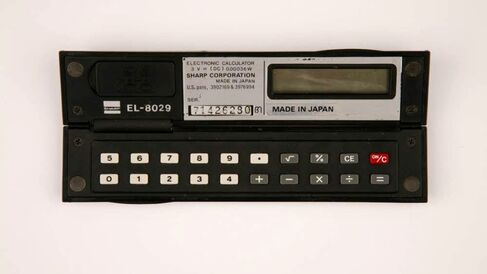The Aesthetics of Calculation

Pocket electronic calculators were not necessarily bought for their utility alone. A number of manufacturers focused on making calculators that appealed to the aesthetic sensibilities of their users. Some were designed to promote the instrument's value and exclusivity, whilst others, in a manner similar to certain slide rules and mechanical calculators before them, sought to imitate other handheld objects to assert their convenience.
Many barometer designs have been developed since the invention of the instrument. Issues of portability, scale and accuracy forced natural philosophers and instrument makers to think about how to best enhance the measuring mechanism. This section covers three types of barometer design: cistern, angle or diagonal, and aneroid.
Ever since Torricelli's pioneering work, the barometer has been repeatedly re-designed to improve its portability and increase its accuracy.
Dyed spirit or mercury used in early barometers would stain or get stuck in the tube, and, as barometers had an open tube, mercury often spilled out of the instrument during field expeditions. Cistern type barometers were designed to adjust the mercury level for calibration, and were later designed with a plug valve to prevent leakage.
Bending or folding the barometer tube was another solution to reduce the size of the apparatus. Manipulating the glass tube in this way also amplified the movements of the mercury and enabled designers to increase the increments of a marked scale.
Aneroid barometers did not use liquid to measure air pressure. Instead the flexibility of materials such as metal springs bended and distorted shape according to air pressure. Although the concept of an aneroid barometer was first suggested in the early eighteenth century by the German philosopher Gottfried Wilhelm Leibniz (1646-1716), its successful construction was not realized until the mid-nineteenth century.
The 'touch' of class
One of the most important pocket calculator manufacturers, the UK brand Sinclair, always paid special attention to the design of its devices. Their first model, the 'Executive', was marketed in 1972 as the world's first 'slimline' pocket calculator. With a minimal colour scheme and small buttons designed to feel more solid, the device won a Design Council Award and was sold in the millions and exported around the globe.
In 1976, Sinclair launched the 'Sovereign' calculator in an attempt to create a market for 'upscale' calculators during a time when lower chip prices were leading the market toward decreasing profits. They sold the Sovereign as a luxury tool resembling a remote control, as can be seen in representative advertisements (Image 1). Though not successful on the market, Sinclair anticipated a design-centric approach to computing devices that would subsequently be emphasised by companies like Apple.
Inconspicuous calculation
As calculator chips ceased being a limiting factor in the size of devices, models were developed to resemble other items that one might find in a purse or pocket. The Casio Mini-Card MC-34 calculator and metric converter was designed with miniaturisation in mind, being not much larger than a credit card (Image 2). Sharp developed a calculator that would resemble a vanity mirror, easily disguised amongst other 'feminine' possessions (above). Although these devices did not have the staying power of more powerful scientific and financial calculators, they represent an important phase during which the look and feel of a calculator could be its selling point, in a similar manner to the smartphones we use today.
Mikey McGovern
Mikey McGovern, 'The aesthetics of calculation', Explore Whipple Collections, Whipple Museum of the History of Science, University of Cambridge.
